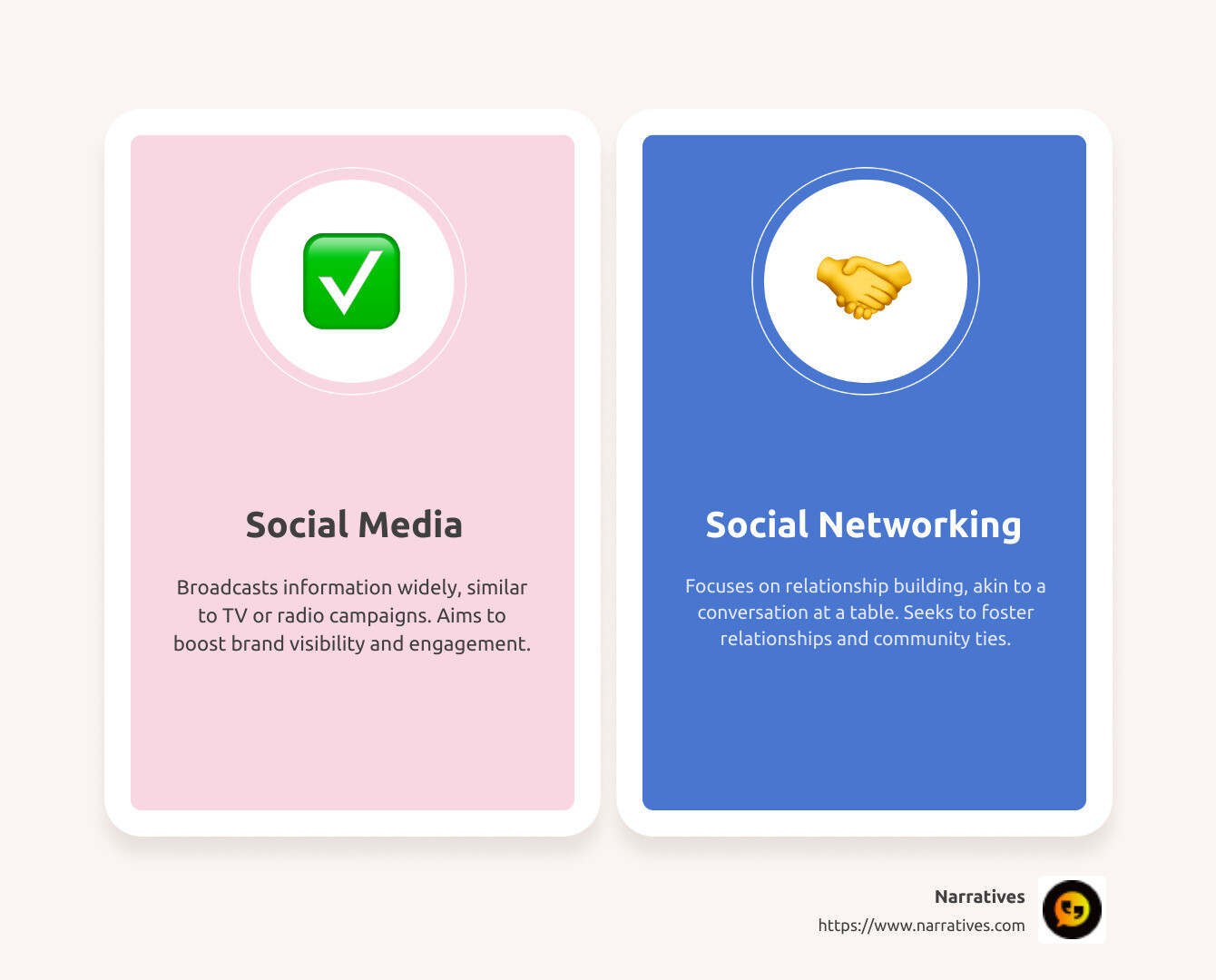Decoding the Digital Divide: Social Media vs. Social Networking

Navigating the Digital Divide: Social Networking Service vs Social Media
Understanding the distinction between social networking service vs social media is crucial, particularly for those steering non-profits or advocacy groups. Here's the gist:
- Social Media is about sharing info with a wide audience. It's like a megaphone for brands.
- Social Networking focuses on building and nurturing direct relationships. Think of it as a conversation around a table.
Both platforms serve essential roles, but their purposes differ, especially in communication styles and goals.
Communication Styles:
- Social Media: Broadcasts info, similar to radio or TV.
- Social Networking: Encourages dialogue and connection.
Goals:
- Social Media: Aims to boost brand visibility and engagement.
- Social Networking: Seeks to foster relationships and community ties.
Understanding these differences helps organizations craft targeted digital strategies, whether they're promoting a campaign or nurturing a supporter base.

Social networking service vs social media terms to learn:
Understanding Social Media
When we talk about social media, we're diving into a world designed for broadcasting information and content-sharing. Imagine a giant billboard, but digital. It's all about reaching as many eyes as possible.
Key Features of Social Media
At its core, social media is about interaction and engagement. But how does it differ from social networking? Let's break it down:
Platforms: Social media platforms like Facebook, Instagram, and TikTok are built for sharing content. They allow users to post updates, photos, and videos to a broad audience. These platforms are designed to catch attention and spark interest.
Interaction: Engagement is key. Likes, comments, and shares are the currency of social media. They help gauge how well content resonates with the audience.
Marketing: Social media is a powerful tool for marketing. Brands use it to promote products, share news, and connect with consumers. It's about visibility and reach.

Examples of Social Media Platforms
Let's look at some of the big players in the social media landscape:
Facebook: Known for its wide reach, Facebook is a hub for sharing everything from personal updates to brand promotions.
Instagram: A visually-driven platform where images and videos take center stage. It's ideal for brands focusing on aesthetics and lifestyle.
TikTok: The new kid on the block, TikTok is all about short, engaging videos. It's a playground for creativity and viral trends.
Each platform has its unique style and audience, making it essential to tailor content for each one.
Social media's strength lies in its ability to broadcast messages far and wide, engaging users through compelling content and interactive features. Understanding these platforms' nuances is crucial for crafting effective digital strategies.
Exploring Social Networking
While social media focuses on broadcasting, social networking is all about building relationships. It's more like having a conversation over coffee, rather than shouting from a rooftop. The goal is to create meaningful connections and foster a sense of community.
Key Features of Social Networking
Social networking thrives on two-way communication. It’s not just about speaking but also listening and responding. This interaction leads to deeper connections and collaboration.
Connections: At the heart of social networking is the ability to connect with others. Whether it's professionals on LinkedIn or friends on Snapchat, these platforms are designed to bring people together.
Collaboration: Social networking platforms encourage collaboration. Users can join groups, participate in discussions, and work together on projects. This collaborative spirit is a key feature that sets social networking apart.
Community: Building a community is central to social networking. It's about creating a space where people with similar interests can come together, share ideas, and support each other.
Examples of Social Networking Platforms
Let's dig into some of the platforms that epitomize social networking:
LinkedIn: Known for professional networking, LinkedIn is where business minds meet. It's a space for career development, industry discussions, and professional growth. It's all about building a network of professional relationships.
Twitter: While often seen as a news-sharing platform, Twitter is also a powerful social networking tool. It enables real-time conversations and networking through tweets and direct interactions. Users can engage in discussions, follow thought leaders, and share insights.
Snapchat: Primarily a messaging app, Snapchat fosters personal connections through its unique features like disappearing messages and stories. It's about sharing moments in a more intimate and personal way.
Each platform offers a unique approach to networking, but all share the common thread of fostering connections and community. Social networking is about more than just making contacts; it's about nurturing relationships and creating a supportive network.
While social networking service vs social media might seem similar, they serve different purposes. Social networking is about relationship cultivation and community building, offering a more personal and interactive experience.
Social Networking Service vs Social Media
When diving into digital interaction, understanding the difference between social networking service vs social media can be crucial. Let's break it down into three key areas: communication styles, content differences, and goals distinctions.
Communication Styles
Social media is like a megaphone. It’s about broadcasting messages to a wide audience. Think of it as a one-way street where you share information, updates, and promotions. Platforms like Instagram and TikTok are prime examples, where the focus is on reaching as many people as possible with engaging content.
In contrast, social networking is more of a two-way street. It’s about having a conversation. Platforms like LinkedIn and Twitter encourage back-and-forth interactions, where listening and responding are just as important as sharing. This style fosters deeper connections and more meaningful exchanges.
Content Differences
The content on social media is geared toward engagement. It’s about catching the eye with visuals, videos, and quick updates. The aim is to get likes, shares, and comments, driving interaction with your content. This is why infographics, videos, and striking images are so popular on these platforms.
On the flip side, social networking thrives on profound conversations. It’s about sharing insights, asking questions, and sparking discussions. The content is often more detailed and in-depth, focusing on building relationships rather than just capturing attention. For example, LinkedIn articles or Twitter threads dig into topics and invite discussion and collaboration.
Goals Distinctions
The primary goal of social media is marketing. It’s about promoting brands, products, and services to a broad audience. Businesses use these platforms to increase visibility and drive sales, leveraging the viral nature of social media content to reach potential customers.
Social networking, however, focuses on relationship cultivation. The aim is to build and nurture connections within a community. It’s less about selling and more about fostering trust and collaboration. Professionals use platforms like LinkedIn to expand their networks, share expertise, and find opportunities for growth and development.
In summary, while both social media and social networking have their place in the digital landscape, they serve distinct purposes. Understanding these differences can help you leverage each effectively to meet your personal or business goals.
Frequently Asked Questions about Social Networking Service vs Social Media
What is the primary difference between social media and social networking?
The main difference between social media and social networking lies in their core purposes and functionalities. Social media is primarily about broadcasting information. It's like a stage where you share content with a broad audience, aiming to capture attention and spark engagement. Think of platforms like Instagram, where visuals and videos reign supreme, and the goal is to reach as many people as possible.
In contrast, social networking is all about building connections. It's a space for two-way communication, where interactions are more personal and meaningful. Platforms like LinkedIn focus on fostering relationships, encouraging users to connect, collaborate, and engage in deeper conversations. This approach is about nurturing a network rather than just broadcasting a message.
How do businesses benefit from social networking?
Businesses gain significant advantages from social networking by cultivating long-term relationships. On platforms like LinkedIn, companies can connect with industry peers, potential clients, and even future employees. This network-building approach helps in several ways:
Trust and Credibility: By engaging in meaningful conversations and sharing valuable insights, businesses can build trust and establish credibility within their industry.
Opportunities for Collaboration: Social networking allows businesses to identify and explore collaboration opportunities, whether it's a partnership, joint venture, or project collaboration.
Talent Acquisition: Companies can use social networking to find and attract top talent by showcasing their company culture and engaging with potential candidates.
Market Insights: Engaging with a network provides businesses with valuable feedback and insights into market trends and customer needs.
Can social media and social networking be used together effectively?
Absolutely! Combining social media and social networking can create a powerful digital strategy. Here's how they can complement each other:
Amplified Reach: Social media can be used to broadcast messages and reach a vast audience quickly, while social networking helps in nurturing those connections over time.
Engagement and Relationship Building: While social media grabs attention with engaging content, social networking deepens those interactions through meaningful conversations and collaborations.
Holistic Marketing Approach: Businesses can use social media for marketing campaigns and brand awareness, and then leverage social networking to build lasting relationships with customers and industry peers.
By understanding and utilizing the strengths of both, businesses can effectively engage their audience, foster relationships, and achieve their goals in the digital landscape.
Conclusion
In today's digital landscape, the distinction between social networking service vs social media is crucial for organizations aiming to effectively tell their stories and engage with their audience. At Narratives, we understand the power of digital storytelling in amplifying the voices of non-profits and purpose-driven organizations.
Digital storytelling is more than just sharing a message; it's about creating emotionally resonant content that inspires action and builds trust. Through our partnerships with non-profits, we help lift underrepresented voices, showcasing their impact stories in a way that captivates and engages audiences.
Our approach focuses on crafting high-quality video and multimedia content that not only highlights the work of these organizations but also connects with the heart of their mission. By leveraging the strengths of both social media and social networking, we assist non-profits in reaching a wider audience while fostering deeper connections within their communities.
Non-profit partnerships are at the core of what we do. By collaborating with these organizations, we help them steer the digital divide, ensuring their stories are heard and their missions are supported. Our services are designed to increase visibility and inspire engagement, ultimately driving positive social impact.
For those looking to harness the power of digital storytelling, we invite you to explore our media network services. Together, we can create content that not only informs but also transforms, making a meaningful difference in the world.
By understanding the nuances of social networking service vs social media, and with the right strategy, organizations can effectively share their stories and build lasting relationships in the digital age.


